#Ghaghra Area
Explore tagged Tumblr posts
Note
so kuch din pehle mujhe ye sapna aaya tha:-
I was in a temple. Very grand, iskcon jaisa. Main murti thi I think redhe Krishna ki? Or it was shreenathji ki (so that would be shreenathji, yamunaji and vallabhacharya ji)
And koi toh celebration chal raha tha. I was wearing a very plain white and green ghaghra. Aur 2 kanthi pehni thi.(context: mere family ke tradition Jo follow karte hai usme bhakti ke completely initiated log 2 kanthi pehente hai and semi initiated ak. So if I was to wear a kanthi, I'd wear one because complete initiation is a ritual Jo haveli me karna hota hai. I've not had the blessings to get that done yet. ) ( kanthi = tulasi mala)
Okk so hua ye ki sabhi raas kar rahe the, including me. Fir, the pandit ji called me near the murti ka jo area hota hai, and kuch pooja kar rahe hai. As I reached there, I remember some vague part of the dream where mere wo hi kapde, somehow started looking so pretty. Dupatta bohot Sundar se drape karne me help ki kisi ne, someone I think applied kajal on my eyes? I think I'm the main person jo wo Pooja karwa Rahi hai/ or ice been chosen/idk but I'm main character. Halfway through he asks me if I'm honouring the things I should when wearing the kanthi. I was embarrassed but honestly Maine kaha ki nahi kar pa rahi. He just smiled.
So he asked me to remove them, but replaced them with a different kanthi? Like ye thode bade beads se bani thi and it was longer, so he folded it in half and put it over my head. It was like a jaap mala types. All this is happening in front of kanha.
And wo pehenke I felt so at peace. So calm and happy and content. I loved the feeling, and I think kabhi kabhi if I think and try I can still feel a small amount of it <333
This dream was so beautiful and maybe this could be a sign for you like shayad badme kanthi pehenne ka pura chance jald hi mile
8 notes
·
View notes
Text
Culture of Jaisalmer
Jaisalmer is honored with a beautiful and energetic culture that mirrors the rich legacy of the past time. The desert city's people's music and dance are a natural piece of its way of life and an excellent combination of past practices, different social traditions, and old-style music. The way of life, language, and customs of Jaisalmer are to a degree impacted by the way of life of the adjoining region, Sind.
The city has such a great amount to propose as far as its way of life, music, engineering, specialties, and customs that individuals from around the world run to this wonderland to experience desert life. Regardless of the unfavorable circumstances faced by Jaisalmer in its landscape and environment, individuals of this spot look cheerful and happy with their lives and are very well disposed and affable ordinarily.
One needs to visit Jaisalmer's towns in order to get the genuine feel of desert life. Towns are arranged a long way from the city with a larger part of the populace living in country regions. The locals for the most part live in cabins (jhopris) made of grass. The vital types of revenue in the towns are cultivating and creature raising. By and large, men go out for work while the ladies care for homes.
Religions Continued in Jaisalmer
Religions in Jaisalmer are a blend of various Hindus, Jains, Sikhs, Christians, and Muslims. The city typifies it the rich social legacy and conventional traditions of the Hindu strict local area. A larger part of the nearby local inhabitants are relatives of the champion gatherings of the Rajput family who are impassioned supporters of Hindu traditions and ceremonies.
Jaisalmer has a colossal populace of Marwaris who are firm supporters of Hindu practices and customs, with Master Shiva, Ruler Vishnu, and the Sun God holding a high spot in the strict petitions to God presented by the district's Hindu populace. Celebrations, for example, Holi, Shiv Ratri, Diwali, Dusshera, and Karva-Chauth are commended in a ton of ceremony and show among Marwaris.
Customary Outfit in Jaisalmer
However Jaisalmer is painted brilliantly from each corner, and the unremarkable foundation is suitably broken by its brightly dressed individuals. Individuals of Jaisalmer are by and large seen wearing brilliant tones like pinks, reds, and yellows, alongside intricate, lovely gems made of silver and metal.
The ladies are either wearing Ghaghra Cholis or Sarees, with the Odhni shaping a fundamental piece of the general clothing of Rajasthani ladies. The Odhni is a long piece of material, the size for the most part being 3 meters by 2 meters, and is worn with Ghaghra Cholis or Lehengas and furthermore collaborated with a Saree during exceptional ceremonious events.
The customary dresses of guys in Jaisalmer incorporate Khol, Pachewara, Bugatari, and Banda. Men are likewise seen wearing Dhotis and an Angrakhi or a Jhari, which resembles a coat worn to cover the chest area. A vital part of the male outfits is their headgear, which is a trademark element of Rajasthani men overall. The Pagri, Potia, Saafa, Sela, and Pencha are not many of the usually worn sorts of headgear.
Languages Spoken in Jaisalmer
Rajasthani is the most well-known language spoken in Jaisalmer among the wide exhibit of dialects spoken in the area. The second-most famous language spoken here is Hindi, taking into account the enormous Hindu populace. Aside from these two dialects, a few occupants likewise talk and write in Urdu. In the meantime, an ever-increasing number of individuals in Jaisalmer can now talk and write in familiar English on account of the cutting-edge school system.
Music and Dance in Jaisalmer
A vital piece of Jaisalmer's rich social and public activity is its music and dance. The people dance and music of this district have been passed on for many ages and are a vital fascination for travelers.
No social or social festival in Jaisalmer is finished without the people's music and dance performed by the profoundly gifted craftsmen of this spot. There are a few local society dance styles that Jaisalmer can flaunt, the Kalbeliya dance style is one of them. This dance structure is principally performed by the local area of snake charmers.
Other Prominent Dance Forms in Jaisalmer
Ghoomar Dance - This exceptional dance structure is performed by females at merry events.
Kathputli Dance - This dance structure addresses the exceptional social custom of Jaisalmer, where coordinators of the show utilize their innovative creative minds to organize a dance dramatization of manikins to engage the crowd.
Architecture of the city
Jaisalmer in entirety portrays the innovative creative mind and rich imaginative abilities of the district's nearby specialists, with their rich structural aptitude found in the Post of Jaisalmer, Nathmalji-ki-Haveli, Salim Singh-ki-Haveli, Parsvanath Jain Sanctuary, and Chandraprabhu Sanctuary. The greater part of the structures in Jaisalmer are exquisitely embellished with fragile and fine work. Individuals from India and the world visit Jaisalmer to see its strongholds, castles, and strict hallowed places that bear amazing gridwork on their walls, support points, and roofs. A few posts likewise have fantastic wooden work that truly deserves notice.
Arts and Crafts
Jaisalmer's specialties incorporate sensitive weaving work, customary gems made of silver, perfectly created cowhide items, stone work, and printing work. The vast majority of the city's occupants are profoundly talented in specialty and fine art, and their work has gotten recognition all over the planet.If you are looking for trip to Jaisalmer via cab then, I recommend you the best taxi service in Jaisalmer named as Jaisalmer Taxi Service Cab. Jaisalmer Taxi Service Cab is one of India's most dependable, cost-effective, and high-quality taxi services. We offer low-cost, high-quality cab services that guarantee a pleasant journey.
0 notes
Note
What are some differences between Pakistani and Indian fashion? How did the Partition affect clothing?
Hi there, sorry for the delayed reply. And the reply is going to be a long one:)Indian fashion as a term is something I struggle with given the numerous states and regions within the country, each with its indigenous style. Nevertheless for the purposes of the reply I will take into account the three largely visible pan-Indian styles i.e. the saree, the ghagra and the salwar/churidar/trouser + kurta.
Rather than seeing it as Pakistan/India, broadly I think the northwestern part of the subcontinent is a “trouser” culture while elsewhere the wrap/skirt is predominant (apologies for using the English terms, I use it just as a means of classification and I am sure most readers can relate it to local terms like salwar, ghaghra, lehenga etc.).
While cultures like Awadh, Bhopal, Hyderabad represent a fusion of several styles and favour trousers, I think it can be said that the north of India (present day and pre Independence) is where the contemporary styles we wear originate. As an example that I always give, Khazanchi made in 1941 was one of the first Lahore productions that found a large Indian audience. That film made the salwar kameez popular and not for no reason is it often referred to as a Punjabi suit in many parts of India. The newly popular palazzo and pant styles in many parts of India also I am sure owe much to contemporary Pakistani/North Indian fashions.
But of course there are variations in this basic template - for e.g. my Delhi friends find Mumbai versions of the kameez and trousers unwearable:) In the South it took a long time to overcome the taboo on divided clothing like the salwar and though that taboo is no longer there garments like the maxi and long skirts are also popular. Furthermore I think the choice of fabric makes a difference - some Indian handlooms for e.g. are intended to give a “saree” feel given borders, fitted blouse like area for the kurta etc.Styles I rarely see in Pakistani fashion.
So on the whole due to various reasons (including the cinema) I would say that Indian fashion draws on Northern Indian trends (which in turn I think are not dissimilar to Pakistani styles) and mixes it with a whole lot of other Indian styles like the saree and lehenga. However, I think post partition the states that had a common culture with Pakistan (e.g. Punjab) have also evolved differently. Not wholly but to some extent. The gharara/sharara for e.g. appear to be more popular in Pakistan than in Northern India - for the former it appears linked to identity whereas in Northern India it probably has a revival now and then.
Re Pakistan post partition, I rely mostly on visual material so its not a “lived” experience of fashion unlike my take on India. Nevertheless it does appear to me that it is a mix of prevalent local styles as well as a conscious attempt at creating styles that represent Pakistani identity for e.g. the adoption of the gharara as a national dress Furthermore I am sure regional influences within Pakistan as well as the influence of countries to its West (Iran, Turkey) also play a role in creating differences in the way style evolves on either side of the border.
As for styles over the decades, I think - like the saree - the Pakistani dress silhouette often reflects international trends (like the sleek styles of the 60s or the more boxy styles of the 80s) but stays faithful to the basic trouser/kameez template. With this template - in my opinion - it is far more adventurous and creative in creating a whole lot of variations. At least that is the impression I get when I see Pakistani suit materials in the middle east that provide a pattern for the suit - there seem to be endless variations possible for the trouser. As well as the kameez which artfully combines a lot of fabric pieces. Plus Pakistanis also seem to be more partial to the dupatta and seem to have a lot more drape styles. On the whole to me the major innovations in India for the most part happen with the saree and lehenga. While Pakistan seems to experiment with and produce far more variations with the trouser/tunic combo.
181 notes
·
View notes
Note
I’m in the northern part of India
A good place for dragons!
Forgive me if my knowledge of northern India is lacking, but as far as I can tell the states in northern India are Haryana, Himachal Pradesh, the Punjab, Rajasthan, Utter Pradesh and Uttarakhand, with the Himalayan mountains on the northern border of India and the Thar desert and associated scrublands towards the west, and the Terai-Duar savanna and grasslands to the north east.
If you are close to the Himalayas, you’ll see the druk (Imperiadraco torridus), specifically the western subspecies (I. torridus nepalus) which has brown-to-golden scales and a mane of green wattles around the head (it is in the longdraconid family, meaning it looks a lot like a stereotypical ‘eastern dragon’). The alpine areas in Himachal Pradesh and Uttarakhand will be good for seeing these animals, as they live at high altitudes, mostly eating sheep and goats such as the bharal (Pseudois nayaur), the tahr (Hemitragus jemlahicus) and a few species of musk deer (Moschus chrysogaster, M. cupreus, M. fuscus and M. leucogaster).
The most famous dragons in India, the nagas (Monoceraserpens indicus) are huge jewel-green serpents with curved, crescent shaped golden nasal horns. You will find the larger specimens in deep rivers (the Ganges being the obvious naga habitat, with rivers associated with the Ganges, the Ganga, Chambal, Betwa, Yamuna, Gomti, Ghaghra, etc.), and smaller specimens may be found in subtropical and tropical forests, such as those in the upper Gangetic plains (Haryana, Rajasthan, Himachal Pradesh, Utter Pradesh, Uttarakhand)
In mythology, they are famed as creatures which can eat elephants (Elephas maximus indicus), and this is especially true for the larger specimens of naga living close to the elephant nature reserves in Uttarakhand and Uttar Pradesh, and as such the conservationists working in these areas try to closely monitor and reduce unruly naga populations. The easiest way to deter the naga is with its natural enemy, the garuda bird, but failing that, a cockatrice (Basiliskos gallimimus) is a good substitute, as the small, chicken-shaped dragons are the unlikely predators of the large nagas.
You will find cockatrices usually in forested areas near farms. They are semi-domesticated animals, in that they will tolerate living among domestic chickens, and may even be handled and housed like a domestic chicken, but they only perform these behaviours so that they can fool the flock, and their prey, into thinking the cockatrice is a mere bird. If possible, they like to wonder around forests with a flock of chickens or similar jungle fowl until a small naga (‘small’ meaning 6ft to 8ft long, the size where they like to hunt in forests rather than stay in the water) attempts to attack the flock for an easy meal. The cockatrice then turns on the naga and sprays a highly venomous toxin, which will blind and injure the animal, and the cockatrice will emit a victory cry to attract other cockatrices, who will then follow the injured naga until death. In countries without a native naga population, the cockatrice makes do with other large animals.
In the mythology of these three animals, the druk is a symbol of good luck and can summon thunderstorms, nagas are holy and beautiful protectors of bodies of water but can sometimes be total jerks (to the point Krishna needed to dance on the naga Kaliya’s head to stop him from being a nuisance) and cockatrices are seen as really deadly monsters (especially in European folklore, these dragons are not mentioned as much in Asian mythology as they are more commonplace animals).
These are the local dragons according to Dracones Mundi, which is a work of fiction based on world mythology plus some ideas from science, hopefully this makes sense!
14 notes
·
View notes
Text
अमोढ़ा-बस्ती: सांसद हरीश द्विवेदी पर अमोढ़ा ग्रामवासियों का दिखा गुस्सा, केवल कागजो में हुए काम को लेकर नाराज थे
अमोढ़ा-बस्ती: सांसद हरीश द्विवेदी पर अमोढ़ा ग्रामवासियों का दिखा गुस्सा, केवल कागजो में हुए काम को लेकर नाराज थे
अमोढ़ा-बस्ती: बस्ती जिले में अमोढ़ा गांव के लोगों ने बीजेपी सांसद हरीश द्रिवेदी का रास्ता रोक कर विरोध किया, विरोध तेज होता देख जिलाधिकारी की सरकारी गाड़ी से निकाले गए सांसद।
सांसद आदर्श ग्राम अमोढ़ा में विकास कार्यों के निरीक्षण के दौरान सांसद हरीश द्विवेदी पर नाराज अमोढ़ा ग्रामवासियों का दिखा गुस्सा, केवल कागजो में हुए काम को लेकर और गांव को खुशहाल और सुन्दर होने के फर्जी आकड़ों को दिखाने से नराज थे…
View On WordPress
#Amorha Area#Amorha Khas#Ayodhya Area#Basti Area#Chandpur Area#Chhawani Bazar Area#Chhawani bazar famous Area#Dubauliya Area#Dubauliya Breaking News#Ghaghra Area#Harraiya Area#Kalyanpur Area#Pachwas Area#Ramrekha Area#Ramrekha River#Ramrekha Temple#Undeveloped Area in Basti#Undeveloped Area in Uttar Pradesh#Uttar Pradesh Area#Vikramjot Area#Vikramjot Breaking News
0 notes
Text
Some Significance Of Designer Indian Wedding Dresses
Fashionable dresses of Indian wedding disclose the diversity and richness of Indian culture and tradition. Each and every area has its special dress code for marriage with their distinguishing color implication. In the north region, dresses for wedding are normally green or red that symbolizes lushness and auspiciousness respectively. Dresses of wedding of the southern area are mostly distinguished by cream color clothing which symbolizes purity and simplicity. Gujarati, Bengali and Kerala tradition has a mixture of red and white Kerala Wedding Dress that relates the rich tradition of their people culture and even signifies the favorable, lavish, and heavenly entry of the newly married girl into a complete new and amazing world.

Any type of region is, the fashion is same all through the nation since long time. In the older days, sarees were used on ceremonies of wedding and even these days sarees holds its elegance and richness. The just possible thing that has transformed is the pattern, design, and the overall draping style of saree. These days, if you want special look then you can buy Wedding Gown Kerala, apart from this wedding sarees are accessible in different designs and styles. The very famous in between them are kanchipuram, Bandhani, zardosi work, silk, patola, brocade and sequence work. With the selection of wedded dresses, you can think about the services of Bridal Boutiques In Kochi to improve your look.
Aside from that, if talking about Wedding Gowns In Ernakulam, then it is known wonderful wedding dress in few areas of the nation mainly in Punjab. The pattern, the style, and the creative work in marriage gown have transformed over the time period. The wedding gown is decoratively decorated with ample of embellishments such as heavy embroidery, beadwork, crystal, golden lace, and sequence and threading. The base is a loose type of gown, a stylish or a good looking and is mainly simple with a heavy type of border at the base end. The Bridal Gown Kerala is even overstated with either the similar adornments like the jewelry or is straightforward with a good-looking gown. It is also tied around the neckline or to the chest according the ease of the bride.
One more momentous attire of Indian wedding is lehanga choli or ghaghra choli. The type of dress is a long designer skirt with a fashionable and designer short top and a matching dupatta. Nowadays, you can buy wedding gown online as there are huge collection of bridal gown is available online. It is mainly planned for the brides; gowns at the present time are available in different designs and style. The very common style is the straight cut, fish cut, and A-line cut. In the past flared cut was even very famous but these days just some prefer wearing a totally flared type of gown for their marriage. The graceful material in tissue, georgette, satin or crepe with the accompaniments like sequence, thread work, zardosi, laces, or crystals insert more beauty and charm to the personality of bride.
On the other hand, reorganized India become, no issue how far the fashion business advances; dresses for Indian marriage have and would forever revolve around salwar kameez, sarees, and gown.
1 note
·
View note
Text
Why is Kailali drowning?
Why is Kailali drowning?
[ad_1] The southern area of Kailali is flooded in the course of the monsoon season. Kailali and Bardiya have been submerged as a result of India’s development of the Girijapuri Dam (Kailashpuri Dam) on the Ghaghra (Karnali) river 10 km south of the Nepal-India border.
After the closure of the dam, the move of water from the Karnali, Mohana, Kanari, Kandra, Patharia, Kandhal and different large…
View On WordPress
0 notes
Text
Gopalganj: Eight died after boat capsize at two different locations
Gopalganj: Eight died after boat capsize at two different locations
[ad_1] In Bihar, almost all rivers are flowing above the danger mark. Rivers such as Ganga, Bagmati, Budhi, Gandak, Kamala Balan, Mahananda and Ghaghra have been flowing above the danger mark in many areas. Due to the increased water level of rivers, 625 panchayats in 86 blocks across 11 districts of [ad_2] Source link
View On WordPress
0 notes
Text
Bihar: Floodwaters enter new areas, hit million more

PATNA: Floodwaters spread to new areas in the 11 affected districts of Bihar, hitting one million more population, even though no fresh death was reported and the toll remained at 10, the Disaster Management Department said on Monday. The latest bulletin, said a total of 24.42 lakh people have been hit by floods in 765 panchayats of 93 blocks of 11 districts with Darbhanga being the worst-hit, where 8.87 lakh people have been displaced in its 14 blocks. The Sunday bulletin had said the number of flood- hit population in Bihar was nearly 15 lakh in 11 districts. Apart from Darbhanga, East Champaran and Muzaffarpur districts are badly affected where 7.0 lakh and 3.20 lakh people have been impacted, the bulletin said. The air-dropping operation of food packets by Indian Air Force helicopters has been stopped from this evening in Gopalganj, Darbhanga and East Champaran districts. The operation had started in these places on July 25. A senior officer of the Disaster Management department said the relief distribution through boats and other means would continue in these places as also in other marooned districts. Each relief packet contains two-and-a-half kg of flattened rice, one kg gram, half kg jaggery, matchbox and a packet of candles which were being prepared at Sri Krishna Memorial Hall in the state capital. People have been forced to leave their homes due to rampaging flood. The situation seems to be more or less same in every affected district. A family in Kaharpur village of Naugachhia sub-division of Bhagalpur district was seen demolishing their home as Kosi river was about to take it in its stride. Asked the reason for doing so, they said that several houses have been washed away in the Kosi water and his house will also be taken away in a few hours so he is removing bricks to use them for another house once the situation improves. In Shormar village of Samastipur where floodwaters have submerged everything, one of the affected people said a vast area has been flooded. Even the school has been badly affected. He said that people don’t have water to drink. It seems that people will have to drink the floodwater after boiling them, he said, adding no help from the administration has reached to them so far. In Baliadangi village of Kishanganj district, people have been surrounded by floodwaters and there is no means to get them out of the place. The total number of casualties stood at 10 in districts with no fresh fatality reported on Monday, the bulletin said. The flood affected districts are Sitamarhi, Sheohar, Supaul, Kishanganj, Darbhanga, Muzaffarpur, Gopalganj, West Champaran, East Champaran, Khagaria and Saran. Seventeen teams of the NDRF and eight of the SDRF are involved in the rescue operations as part of which 1.67 people have been evacuated from the affected areas so far, the bulletin said. Besides, 12,858 people are staying in 29 relief camps while nearly 3.28 lakh people were being fed at 703 community kitchens. National Disaster Response Force (NDRF) Commandant Vijay Sinha said his personnel have so far evacuated 6600 affected people and cattle to safer places in Gopalganj, Saran, East Champaran, West Champaran, Darbhanga and Supaul. Besides, the NDRF has also been helping the district administration in distributing relief materials, Sinha said, adding teams have helped medical personnel reach affected rural areas. The flood relief work has been quite a challenge this year in view of the raging COVID-19 pandemic, he said. Several rivers such as Baghmati, Burhi Gandak, Kamlabalan, Lalbakeya, Adhwara, Khiroi, and Ghaghra are flowing above danger level while the water level of Ganga is increasing at Hathidah, Munger, Bhagalpur, and Kahalgaon. Though the level has gone down at Gandhi ghat in Patna, it has remained steady at Buxar and Digha in Patna, a Water Resources Departments bulletin said. Meanwhile, Chief Public Relation Officer (CPRO), of East Central Railway zone, Rajesh Kumar, said some trains in the Darbhanga-Samastipur section have been diverted due to floodwaters coming up to the girder of Railway bridge in between south Hayaghat and Thalwara.
The post Bihar: Floodwaters enter new areas, hit million more appeared first on BBC BREAKING NEWS.
from WordPress https://bbcbreakingnews.com/bihar-floodwaters-enter-new-areas-hit-million-more/
0 notes
Photo

I had an anon question as well as an earlier question on wordpress that I will answer here together as they are kind of related.
1. I saw an early 19th century painting which showed women in a blouse and sari. I always thought blouse was introduced by Jnanadanandini Devi?
I think some sort of blouse (and possibly a kind of petticoat given ghaghra cholis and related outfits) was always around. Even Ajanta paintings have a few examples. This early 19th century painting is an example of it too:

But I think the formal kind of blouse, often influenced by prevailing Victorian fashion, and the petticoat worn with a sari did come in with both styles in Western India as well as in Bengal in the 1870s. A few books of the time and later refer to shops selling “jackets” which term seems distinct from the choli.
The early 20th century Dhurandhar painting right on top shows differing blouse styles, from the indigenous choli to the modified choli with puff sleeves as well as more elaborate versions which are obviously Victorian in origin suggesting a variety of styles after the 1870s. In summary I think the sari blouse was around but not essential. Especially in the hotter areas of India where a sari sufficed. From the 1870s onwards, however, it became an essential part of attire for educated women and then all women.
2. Several months back I had a query regarding Jnandanandini Devi’s introduction of the Brahmika (Brahmo woman) drape from Sari Sisters. The query was on the difference between the Brahmika drape and Classical Bengal drape and whether the only difference was in the pleats on the shoulders.
At the time I assumed that there wasn’t much difference between earlier sari drapes in Bengal and the Brahmika saree. But the question stayed in my mind and I had some time this weekend to poke around a bit. Not much came up. Though everyone agrees that the Brahmika drape was novel and inspired by the Parsi/Gujarati drape that Jnanadanandini saw in then Bombay, the exact nature of the earlier drape is not clear. Instead there is more emphasis on the introduction of accessories like the blouse, petticoat, hair net etc, which assisted in making the saree a dress for a bhadra (respectable) woman. Nevertheless there was some change since there are many remarks both on the untidiness of draping as well as the immodesty of previous drapes.
The only clear reference I got was in Rochona Majumdar’s book (Marriage and Modernity) where she mentions that the traditional style is the pallu (end of the sari) wrapped around the waist or hanging in front rather than the pleats of the Brahmika saree. As it happens there aren’t too many pre 1870 pics that I could find except these.

Rabindranatha Tagore’s mother on the left (presumably an older style, though it isn’t clear to me if the pallu is tucked around the waist and also on the shoulder). On the right a milkmaid of the 1840s, this drape has some resemblance to the Brahmika style but has no pleats and is simply wound around.

The Parsi/Gujarati style is seen above which is the seedha (straight) pallu style with the sari being secured on the right shoulder.

The Brahmika/Bengal styles are above. The style arranges the saree border in a way that mimics the seedha pallu (more evident in the left pic of girls in 1904*) but the pallu is eventually thrown over and secured at the left shoulder. So it does appear that the sari sisters were right in that process of pleating and arranging the sari in the upper part was probably different for the Brahmika saree (though some of the modern Bengal saree drape tutorials have a bit of a pleat arrangement in the bottom part too. Further the loose end can be thrown over the right shoulder).
As always feel free to comment/inbox and do let me know if Bengal has more draping styles or if there are differences I missed.
*1904, courtesy Geraldine Forbes.
109 notes
·
View notes
Photo

#UttarPradesh: Three boys drowned in the Ghaghra river on Monday, while two others are reported missing in Athgawa area of #Ballia district. https://www.instagram.com/p/B_y1H1zncIX/?igshid=1iir3ua854vx3
0 notes
Text
15 Reasons Why Madhuri Dixit Will Always Be The Queen Of Bollywood
Madhuri Dixit’s is a face that we all know. Whether we grew up watching her on the screen, or we’ve become acquainted with her work, now, there’s a part of us that will always love the superstar. Our parents loved her, we love. And dear uncle ji, I know you’re reading, and I know you’re still hopelessly in awe of the beauty that she is, but that’s okay cuz so are we. Here are all the times humaara dil dhak dhak kerney luga because of Madhuri ji. 1. First off, Madhuri Dixit is 50 years old and she still looks like this
2. Her adaayein can still make any man go weak in the knees
Known to be one of the most beautiful women in the Bollywood industry, Madhuri Dixit Nene still has it to spellbind any and everyone.
3. From her debut till now, she’s been winning hearts all over the world While the film didn’t do so well at the Box Office, Madhuri’s talent was recognized by critics and directors alike.
4. She dazzled people with her talent in Dil Working opposite Aamir Khan proved lucky for Madhuri as her performance in the hit film Dil earned her a Filmfare Award For Best Actress. She wowed everyone with her talent and bagged the award in just four films.
5. And then took it all to another level with this one Possibly the most sensual song in all of Madhuri’s career, Dhak Dhak Kerne Laga, was a shining point in Madhuri’s career. The song, till today, is on most desi playlists. It’s in every ode to Madhuri. And it’s a song that every bacha bacha knows. 6. Her portrayal of a courtesan in the solid hit Devdas left many hearts broken and many eyes weeping For a courtesan to fall in love; for a woman to know that the man she loves won’t ever let her touch him, will never be hers. That he will always be in love with the one he left behind. She cared for Devdas and tended to him. She nursed him back to health, and then was willing to give him up when Paro came back.
7. Aaja Nachle was Madhuri’s debut after almost a 5-year long hiatus from the Hindi film industry The film tanked at the box office, however, Madhuri’s performance was appreciated greatly. Film critics the likes of Rajeev Masand said that it was next to impossible to take your eyes off of this ethereal beauty on screen. While the film didn’t do so well, her acting did.
8. Playing a con woman in Dedh Ishqiya, she stole many hearts After another hiatus, Madhuri came back in Dedh Ishqiya opposite industry veteran Naseeruddin Shah along with Huma Qureshi and Arshad Warsi. The woman looked gorgeous in every frame and it was hard to not fall in love with her all over again.
9. Gulab Gang is an all-out a woman-centric film, is also the last film Madhuri has acted in The leader of a gang whose sole mission is to protect women from the vices of society, the film is about the trials and tribulations that she has to go through, in order to protect her gang and the woman of her area. Action, politics, struggle, and emotion. The film was a complete package and a showcase for Dixit’s talent.
10. While we’ve had many films come out, we can’t forget Maya in Dil Tu Pagal Hai The epitome of grace and beauty, and the realization of Rahul’s dreams, Maya was a character that everyone was in love with. Whether it was Madhuri’s dancing skills, her chemistry with both Shahrukh Khan and Karisma Kapoor, it all presented us with one of the most heartwarming stories we’ve seen in recent times.
11۔ Or the absolutely adorable Nisha in Hum Aapke Hain Kaun The transition of the whacky, crazy Nisha from the first half of the film, to the serious, more mature, and responsible one from the second half, was reason enough for Madhuri to justify her position on top of the acting pyramid. However, there was so much more to the film. Character development, emotional fluctuations and working with such a huge cast. 12. While Radha from Hum Tumhaare Hain Sanam completely blew us away p> She was kind and compassionate but fiercely protective of her family. And even Shahrukh Khan’s character starts doubting her, she tried her best to fix things.It was a simple script but Madhuri, Shahrukh, and Salman took it to another level with their acting prowess. 13. We were absolutely smitten by Mohini in Yeh Jawani Hai Deewani Source: Dharma Productions The fact that Ranbir Kapoor has had the biggest crush on Madhuri has been no secret. And with a seven-minute appearance in Ranbir’s Yeh Jawaani Hai Deewani, Madhuri proved why she is worth every bit of the adulation that she garners from people of all ages. Madhuri playing a dancer uses her razor-sharp dialogues to put our hero, Bunny, in his place. And then starts the dancing! Ghaghra became a rage, with everyone trying to copy those moves but there really is only one Queen, right? 14. It’s her style and the grace that she exudes that makes her who she is Source: Boney Kapoor Films From being an epitome of grace in desi lehengas and sarees to rocking gowns on the red carpet, Madhuri is equally at ease in everything that she wears – and that has mostly to do with her own innate sense of style. Oh and the perfect accessory that you will never see her without – her million dollar smile! 15. It’s hard not to be in love with the woman Source: Raj Kumar Santoshi Madhuri has been a part of our lives for so long that it is hard to imagine Bollywood without her. She has proven herself time and time again – through her dancing, her acting finesse, and her charm. How can anyone not love her? There hasn’t yet come a woman in the Hindi film industry that can shake Madhuri off of her throne as the Queen of Bollywood. What’s your favourite role of hers?
4 notes
·
View notes
Text
माटू हमरू, पाणी हमरू, हमरा ही छन यी बौण भी… पितरों न लगाई बौण, हमुनही त बचौण भी। (Soil ours, water ours, ours are these forests. Our forefathers raised them, it’s we who must protect them —Old Chipko Song )

The state of Uttarakhand, earlier referred to as Uttaranchal, is located in the northern part of India. Often called as the Land of Gods – Dev Bhumi owing to the innumerable temples and teerth or pilgrimage sites found throughout the state. The famous Char Dham (Kedarnath, Badrinath, Gangotri, and Yamunotri), considered to be the among the holiest sites in India, are in Uttarakhand. Besides the religious significance of the state, Uttarakhand is also well known for its natural beauty that comprises of snow capped mountains, both low and high altitude lakes and associated wetlands, bugiyals or high altitude meadows, and dense forests that are a home to many exotic and diverse flora and fauna.
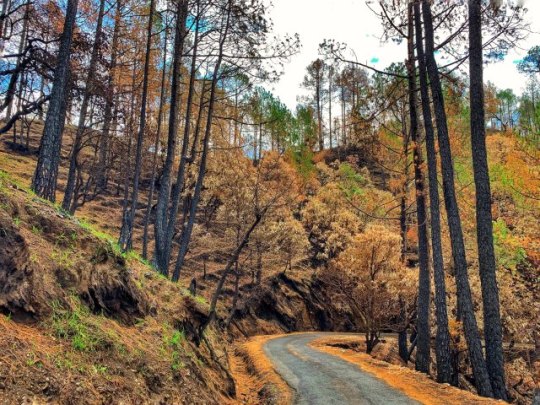
The beautiful forests of Binsar in Uttarakhand (Almora)

Beautiful view of snow peaks from Lansdowne in Uttarakhand (Pauri)
The name Uttarakhand has originated from two Sanskrit words: uttara (उत्तर) meaning north, and khaṇḍa (खण्ड) meaning land. The name is mentioned in many of the early Hindu texts, wherein it referred to the area of Kedarkhand (modern Garhwal) and Manaskhand (modern Kumaon). In ancient India, Uttarakhand was used to denote the central stretch of the Himalayas.
“The land north of Gangadwar is known to the wise as Paradise Ground. Apart from this land, the rest is called Earth elsewhere”― Kedarkhand Skanda Purana.
The state of Uttarakhand was formed on 9th November 2000, by carving out the Himalayan and some adjoining districts in the foothills of Uttar Pradesh, and was made into the 27th state of the Republic of India. It shares borders with the state of Himachal Pradesh to the north west, Tibet Autonomous Region (of China) on the north, Nepal on the east, and the state of UP in the south, while doing a touch and go with Haryana in the west (the Hathni Kund Barrage area from where the Yamuna waters are diverted to Haryana). Uttarakhand is the birth place of four large river systems: the Ganga, Yamuna, Ramganga, and Sharda. The state has two divisions: Garhwal and Kumaon with a total of 13 districts.
Divisions Districts Kumaon Division Almora, Bageshwar, Champawat, Nainital, Pithoragarh, Udham Singh Nagar Garhwal Division Chamoli, Dehradun, Haridwar, Pauri Rudraprayag, Tehri, Uttarkashi

Naukuchiatal in the Nainital district of Kumaon
The entire hill state of Uttarakhand had remained culturally and socially united right from the ancient times, and the two tracts Kedarkhand (now Garhwal) and Kurmachal (now Kumaon) were mere geographical divisions. Kedarkhand was named after Kedarnath, and Kurmachal named after Kurmavana. The two regions were not culturally or politically divided and remained so even under the Katyuri dynasty that ruled from 800-1100 CE. It was only during the 12th century CE that two political divisions appeared, because at that time the Chand dynasty took control of the area now known as Kumaon, while the Rajas of Garhwal controlled the region of Garhwal. Despite the two different dynasties, the region remained united in cultural and social contexts.
Thus, it can be said that in the ancient times the entire region (as we find mentioned in the epics and Puranas) had stretched from the river Kali as the border in the east, and Tons river as the border in the west, Niti pass in the north, and Thakurdwara of the present Moradabad district in the south. For many years the people of this region enjoyed a homogeneity, in the context of social, cultural, and political lives of the common people. It was only the administrative units created in the 20th century that brought in the divisions and further changes.
My focus here will be on the Kumaon division of Uttarakhand.

Looking at Kumaon from a Geographical Perspective
Geographically Kumaon is located in a north west corner of North India, and its is well demarcated from its neighbouring states and countries by mountain and rivers. In the north it is separated from the autonomous region of Tibet by the snowy peaks of the Himalaya, in the east river Kali separates it from Nepal, and in the south the Himalayan foothills separate it from the plains of UP.
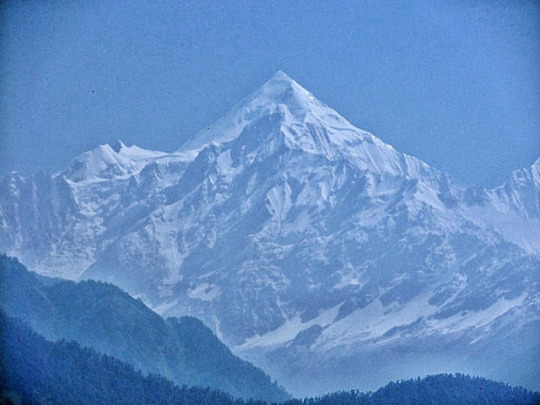
View of the Panchachulli from Munsiyari in Kumaon
The Kumaon division rises sharply from the sub Siwalik (foothills) strip of land to the high snowy peaks with glaciers. The outer ranges of the Himalaya, a part of which is known as Gagar ranges, rises quickly from submontane tracts to 7000-8000 ft, where many of the famous hill stations, such as, Mussorie, Nainital, Almora, Lansdowne, etc., are situated. This part is especially beautiful with its densely forested parts; and when standing at the tops of peaks that often reach more than 8000 ft, the view is spectacular with plains visible on the southern side, and the endless waves of entangled northern ridges on the other side that is bordered in the horizon by beautiful snow peaks of the central axis of the Himalaya. The outer ranges of the Himalaya hold some beautiful low altitude Himalayan lakes, such as, Nainital, Bhimtal, Sattal, Naukuchiatal, Malwa tal, and Khurpa tal. It is believed that most of these low altitude lakes were formed by tectonic movements that blocked rivers during the Holocene period.
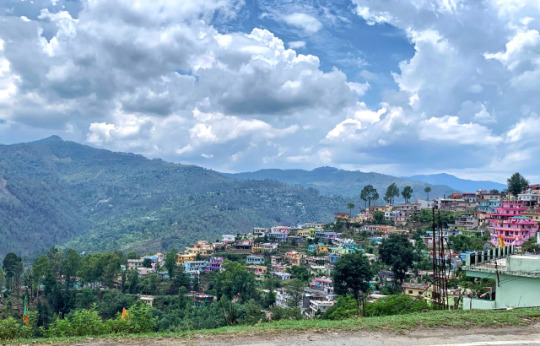
Almora town

Spectacular views from the Gagar ranges (Nainital): endless waves of entangled northern ridges bordered by snowy peaks of the central axis of the Himalaya in the horizon. (photo courtesy: Atanu Dey)

Nainital. A low altitude Himalayan lake in the outer ranges (Gagar ranges). (photo courtesy: Atanu Dey)
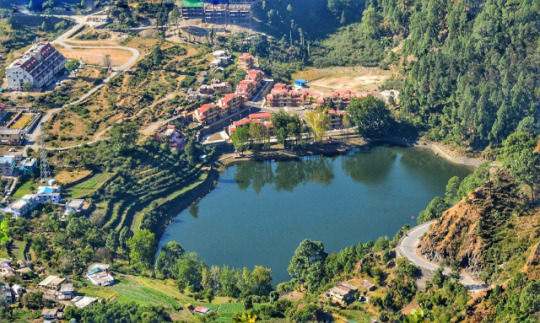
Khurpa tal. Another low altitude Himalayan lake in the outer ranges (Gagar ranges) near Nainital. (photo courtesy: Atanu Dey)

Bhim tal. Another low altitude Himalayan lake in the outer ranges (Gagar ranges) near Nainital.
The Bhabar, a strip of land with gently sloping mass that contains mainly riverine debris (coarse gravels), is just below the hilly tract. It is here that the mountain streams descending from the outer ranges and Siwalik hills lose their flow amidst strewn boulders, and re-appear only during the monsoons. It is forested (sal), with many of the forests now having given way to cultivated areas. The rest of the foothills are known as Tarai grassland region, which is primarily moist plain land with the Tarai springs that keep the area perennially hydrated and fertile. Tarai vegetation is characterised by tracts of clayey swamp (Gangetic alluvium), tall grasslands, deciduous forests, and scrub savannah. The three main rivers in Kumaon division are the Kosi, Gola, and Nandhaur. The Kosi river (or Kaushiki, as named in Skandapurana) starts from Dharapani in Almora district, while the Gola and Nandhaur arise from somewhere in the southern slopes of the outer hills. All the three rivers, and other smaller streams in the Bhabar and Tarai areas all drain into the Ramganga. The other major river on the Nepal-Kumaon border is the Sharda river (also known as the Kali Ganga or Maha Kali) that descends from the Kalapani territory, and joins the Ghaghra/Karnali river in the state of Uttar Pradesh.
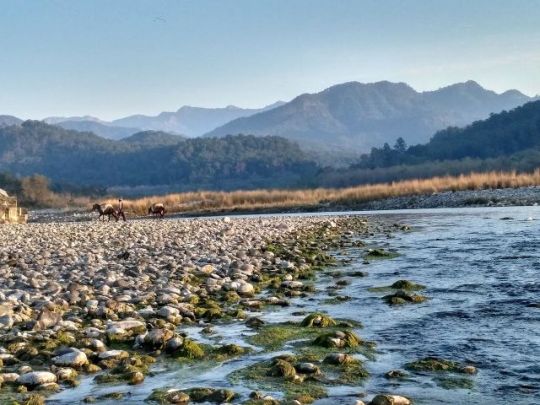
Kosi River, Jim Corbett National Park, Ramnagar- Almora district (Photo from Wikipedia)
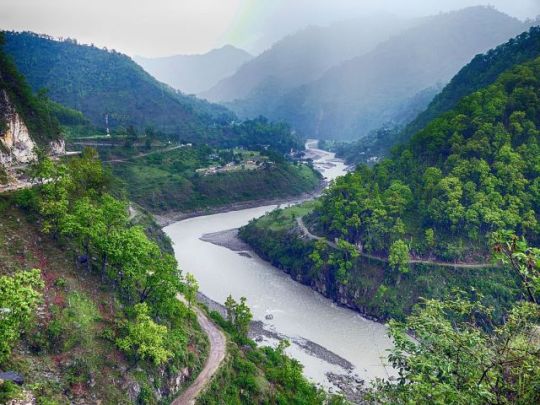
Sharda or Mahakali River near Jauljibi in Pithoragarh district of Kumaon (photo source: Wikipedia
The lower sub-Himalayan ranges show Upper Tertiary era deposits of Nahan sandstone, while the higher ranges are made of older slate, quartzite, dark dolomite or limestone, and other schistose and granite rocks. Owing to the heavy rainfalls experienced in these areas the steep slopes often give way to massive landslides. Kumaon, which is situated on the southern slope of the Himalayan range, show great variations in climate and vegetation that change drastically with changes in elevation, ranging from glaciers at its highest elevations, to subtropical forests at the lower elevations, to grasslands at the flat lands on foothills. While travelling in car these changes are clearly visible, as one moves from the lowlands of Terai that show mostly grasslands, and Bhabar with its remaining pockets of sal forests; to the higher hills that are filled with coniferous and broad-leaf forests, alpine shrubs, and meadows; and finally to the snowy peaks of the Upper Himalaya.

Sunrise from behind the snowy peaks of the Panchachulli range, Kumaon
Origin of the name Kumaon
A look at the history of this area shows that the SkandaPurana (Manash Khanda) refers to this part as Kurmavana or Kumaravana; and it is believed that the word Kumaon is a corruption of the original Puranic term. According to folklore, Vishnu had reincarnated here in Kumaun (near Lohaghat) as Kurma (his second incarnation), to support the Mandar mountain during samudramanthan.


Kurma Avatar of Vishnu, below Mount Mandara, with Vasuki wrapped around the mountain, during Samudra Manthan. ca 1870. (Photo from Wikipedia)
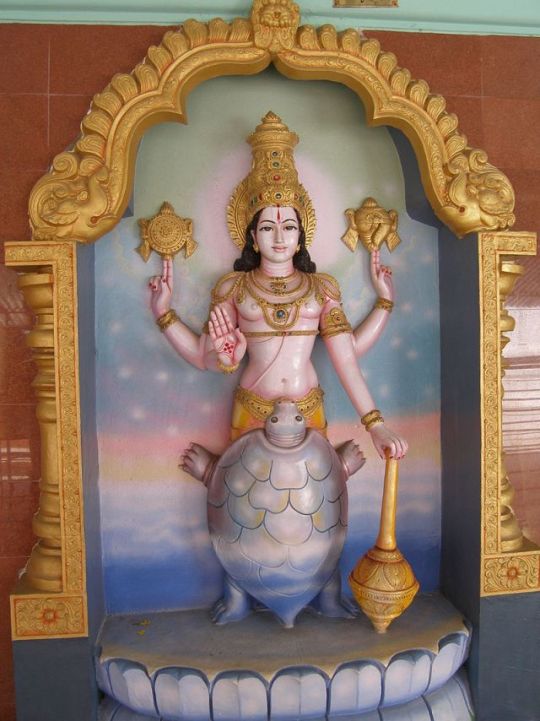
Kurmavatara of Lord Vishnu at Narayana Tirumala (Photo from Wikipedia). Kurma in the Vedic texts symbolises the importance of basic principles and the support necessary for any long term creative activity. In Shatapatha Brahmana (6.1.1 and 7.5.1) Kurma’s shape represents the hemispherical shape (assumed) of the earth, and it is for this reason kurma shape is one among the Vedic fire altar designs.
According to Kumaoni folklore, Vishnu in his kurma avataar stood here for three years on the Kurma-mountain (Kandadeva or Kandeva), which is on the east of the river Champavat, and marks of the tortoise’s feet still remain as imprints. It is for this reason that the region came to be known as Kurma + achal or Kurmachal, which got morphed into Kumu, and later to Kumaon. Initially only the areas around river Champavat were known as Kumaon, but later the whole pargana of Kali Kumaon that comprised of villages along the Kali river came to be known as Kumaon. Later during the reign of Chand dynasty, the entire region, which included the districts of Nainital and Almora, was renamed as Kurmachal or Kumaun. During British rule the Dehradun district also was included in Kumaun.
It was the Chand dynasty rulers who made the term Kurmachal or Kumaon widely popular in this hill state, and prior to their reign there are no mentions of Kurmachal or Kumaon in any of the inscriptions found. The Chands used Kurmachal in all their records. Under their rule that lasted from 11th c. CE to 1815 CE, there were three administrative divisions in Kurmachal:
(i) Kali Kumaun, (ii) Almora, and (iii) Tarai Bhawar or Mal.
Interestingly, while most believe that the term Kurmachal was derived from Kurma, Thakur Jodh Singh Negi in his Himalayan Bhraman had opined that as the people of Kumaon were expert farmers and also quite wealthy, so this region came to be known as Kumaon, derived from the local dialect kumuno, which means a cultivated land. He further theorised that the region Kali Kumaon was named not after the river Kali but after Kalu Tadagi who had once ruled the area, and owing to the presence of thick black bushes of fir and banjha, the adjective ‘Kali’ got added to it. While these theories may provide some interesting viewpoints, they are certainly not based on any historical evidences. Linguistically too, Kumaon as a derivation from Kurmachal appears more logical.
Currently Almora, Bageshwar, Champawat, Nainital, Pithoragarh, and Udham Singh Nagar form the Kumaun division; however, linguistically Kumaon can be further sub divided. Thus, we find that Kali (or Central) Kumaoni dialect is spoken in Almora and northern Nainital, while North-eastern Kumaoni dialect is used in Pithoragarh. South-eastern Kumaoni is spoken in South-eastern Nainital, and Western Kumaoni is spoken west of Almora and Nainital.
While originally the people of Kali Kumaoni were the only Kumaonis, with the Nainital and Almora people being later additions; yet the people from Gangoli and Chaugarkha that are parts of Kali Kumaon, are not termed as Kumaonis, but are called Gangolas and Chaugarikhiyas.
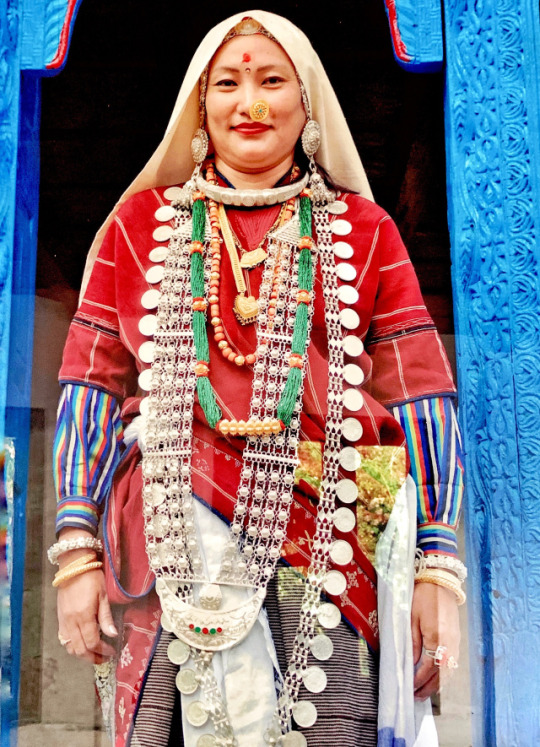
A Kumoani woman in full traditional attire and jewellery (photo from KMVN – Binsar). The common daily wear is now of course a saree, for more practical reasons suitable for a working woman.
Kumaon history
The archaeology based history of the region remained sketchy for quite some time owing to disjointed facts and sporadic records that were available until the 19th century CE. In terms of literary history, the region finds many fleeting references in the epics and the Puranas. Mahabharata mentions this area frequently, especially where it talks of the Kiratas who lived near the sources of the Ganga and Yamuna. The Khasas or Khasias come next, who are found mentioned in the Mahabharata as living in the same areas as the Kiratas. Pliny mentioned Casiri, which many historians identify as the Khasias. Herodotus also mentioned of people living in this area as “Indians who lived in the city of Kaspatyrus.” Ptolemy had written about a group of people living in this area, which Cunningham studied extensively and identified them with the Kulindas of Mahabharata. The Yaudheyas (5th c. BCE – 4th c. CE), a military confederation, had also ruled this area at some point of time, as evident from the coins found. The Kalsi rock edicts of Ashoka (260 – 230 BCE), discovered by Alexander Cunningham in 1850, are important pieces of archaeological evidences that mention the people living in this region.
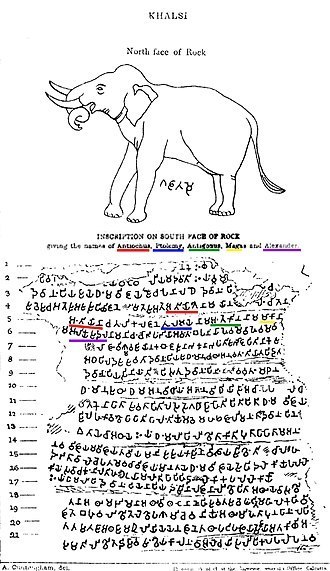
Edict No13 of Ashoka, Khalsi inscription, with the identification of Hellenistic kings Antiochos II, Ptolemy II, Antigonos II Gonatas, Magas of Cyrene and Alexander II of Epirus. these edicts were found in Khalsi in Dehradun district. (photo from Wikipedia)
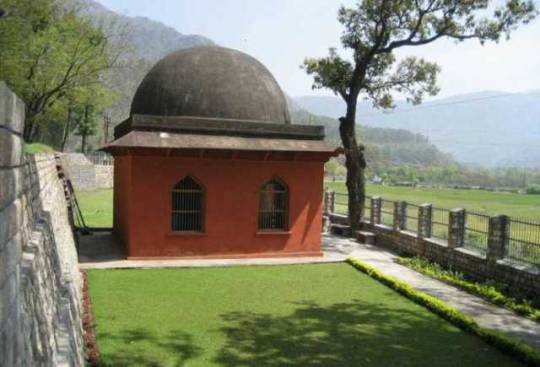
The Kalsi inscriptions are now housed in this room and maintained by the ASI. (photo from the internet). Kalsi is a small town located between Chakrata and Dehradun near Dakpatthar on the banks of Yamuna. The inscriptions found here are important as these are the only Ashokan edicts found in the hill states of north India. The edicts are written in Pali.
It is believed by D. R. Bhandarkar that the Khasas were the first to settle in the hilly tract of Uttarakhand, followed by the Gurjaras who came in after 6th c. CE and took over Sapadlaksha (the area around Shivalik ranges stretching from Hoshiyarpur -Punjab to Kumaon), and it is from here that the Gurjaras later moved down to what is now the state of Rajasthan.
ET Atkinson had done some extensive researches on the available cultural, social, and historical data of the area, and had recorded it in his pioneering work titled “Himalayan Districts of the North-Western provinces of India,” published in 1884. Later discoveries and studies of the various inscriptions such as the Jageswar inscriptions, Lakhamandal inscriptions, the two Talesvara Copper Plate, and Pandukesvar inscriptions have given some significant insights into the 6th-7th CE history of the area. There are many more such later period research works on this arena by Rahul Sankrityayan, H.K. Raturi, S.P. Dabral, and B.D. Pande.
Much later, extensive studies of fossil remains found from rocks in this region that date back to 18.3 to 0.6 million years BP have opened up a vista of the prehistoric era as had existed here. The fossil studies have revealed “a variety of Stresirhine Primate genera, Cercopithecoid genera, and Hominoid genera, the last one being of special interest to hominid ancestry. Significantly, Kalagarh Basin (District Pauri, Uttarakhand) has also witnessed Hominoid activities some 11 to 10 million years ago. These include Sivapithecus indicus and Ramapithecus punjabicus. These hominoids form important links in the evolution of hominids” (Archaeological Survey of India, Dehradun circle). Furthermore, the recent discoveries of “Palaeolithic era tools from Potwar (northern Pakistan) dated between 2.4 and 2.0 million years BP, and from Uttarbaini (Jammu and Kashmir, India) dated between 2.5n and 0-5 million years BP” have given rise to the theory that the Himalayan region could have been the cradle of the earliest hominids of the world.
Recent archaeological studies of this region have given an insight into the different technological stages of human evolution ranging from the Stone to Copper, and Iron Ages (pre-and protohistoric periods). Meanwhile the historical studies from different numismatic, literary, and epigraphical evidences, give us the names of some of the important dynasties that have ruled this area. These include the Kunindas (2nd BCE to 4th c. CE); while in the 4th CE we find that the area was known as Karttripura kingdom, a vassal kingdom under the Guptas (as written in Samudra Gupta’s Parayaga Prasasti).
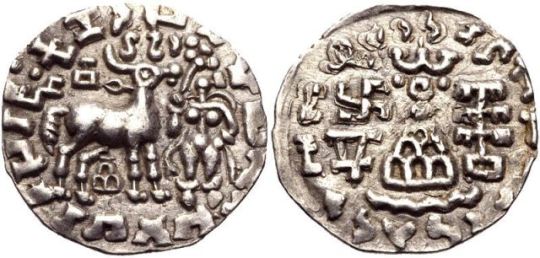
Silver coin of the Kuninda Kingdom, c. 1st century BCE. (photo from Wikipedia)
From the Talesvara Copper Plate Inscriptions of Almora we find that this region was called Brahmapura in the 6th-7th c. CE, during the reign of the Paurava-Varmans. The name Brahmapura is found in the Vrihatsamhita, while Heiun Tsang also mentions it in his 7th c. CE travel book (he writes it as as Po-lo-hi-mo-pu-lo, that in Sanskrit translates to Brahmapura). The kingdom of Brahmapura declined by the end of 8th c. CE, and next came the Katyuris, who ruled from 9th -12th c. CE. From various inscriptions it is clear that some parts of this area came under the dominion of the Mallas of Nepal from 1191 CE to 1223 CE, and that effectively ended the Katyuri rule, though later inscriptions show that the Katyuris survived as petty rulers of smaller areas. After the Katyuris, eventually from 11th century onward emerged the most powerful dynasty of Kumaon, the Chand dynasty, who kept control until 1815. The British conquered it in 1815 and took over the area, which remained with them until 1947.
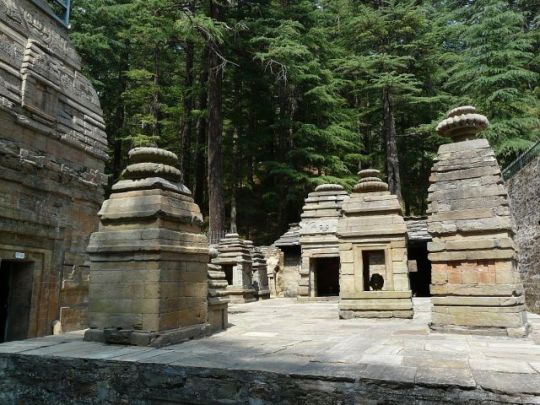
Katarmal sun temple built by the Katyuris in 9th c.CE

Bineswara temple built by the Chand dynasty in 16th c. CE

Jageswara temple cluster. Built between 7th to 12th CE, with renovations going up to 17th century under the Chand dynasty
References
Pande, B. D. History of Kumaon: English version of “Kumaon ka itihas”. Almora, U.P., India: Shyam Prakashan: Shree Almora Book Depot, 1993.
Omacanda Hāṇḍā, History of Uttaranchal. Indus Publishing, 2002.
Kanti Prasad Nautiyal, The Archaeological of Kumaon, 1969.
Alexander Cunningham, Archaeological Survey Report, vol. II.
Bhandarkar, D. R. Gurjaras (Art.), J B B R S, Vol. XXI,1903.
Hermann Goetz, Studies in the History and Arts of Kashmir and the Indian Himalayas, Weisbaden, 1969.
Archaeological Survey of India, Dehradun circle –https://www.asidehraduncircle.in/uttarakhand.html
Kurmachal or Kumaun – The land of Vishnu माटू हमरू, पाणी हमरू, हमरा ही छन यी बौण भी... पितरों न लगाई बौण
#almora#art#binsar#chanddynasty#culture#explorer#hinduism#history#jageswara#katarmal#katyuris#mountains#nainital#people#photography#religion#travel#Uttarakhand#Uttaranchal#uttarpradesh
0 notes
Text
This Story Behind Thick Oil Paint Will Haunt You Forever! | Thick Oil Paint
A Rogan artisan uses paints on bolt application a blubbery blithely coloured paint-like actuality fabricated with brush berry oil
Rogan, a 300-year-old ability attitude that already flourished in Gujarat’s Kutch region, today rests in the easily of Abdul Gafur Khatri’s ancestors in Nirona apple in the area. A bolt painting ability that has been handed bottomward through the men, Rogan graced mainly ghaghra-cholis, conjugal trousseaus, bedsheets and tablecloths. It now adorns added abreast items.
A Rogan artisan uses paints on bolt application a blubbery blithely coloured paint-like actuality fabricated with brush berry oil. Artisans abode a baby bulk of the adhesive into their palm, and the acrylic is anxiously moulded into patterns application a metal rod at allowance temperature.
The rod, which acts as a paintbrush, never comes in acquaintance with the fabric. Later, artisans bend the fabric, creating a mirror angel and with it, a architecture symmetry.
Lack of opportunities took it to the border of extinction, with absolute villages that practised the art switching to added trades. In 1983, a adolescent Abdul Gafur Khatri followed the trend and went to Ahmedabad and Mumbai to acquisition work. There were no tourists visiting Gujarat afresh and the art was not selling. It was alone afterwards a government activity that the art was active again.
Gafur became so absorbed to Rogan that he took it to the all-embracing level. Rogan art was presented to Barrack Obama, by Narendra Modi back he visited the US in 2014. Abdul Gafur Khatri has been awarded the Padma Shri (2019).
This Story Behind Thick Oil Paint Will Haunt You Forever! | Thick Oil Paint – thick oil paint | Welcome in order to the blog, in this moment I am going to teach you in relation to keyword. And now, here is the primary impression:
impasto detail of oil paint brush strokes and pallet knife in a .. | thick oil paint
Think about image earlier mentioned? can be that amazing???. if you think so, I’l t explain to you some impression yet again below:
So, if you desire to have all these awesome photos regarding (This Story Behind Thick Oil Paint Will Haunt You Forever! | Thick Oil Paint), just click save button to save the pictures to your pc. They’re all set for down load, if you like and wish to obtain it, just click save badge in the post, and it will be instantly saved to your laptop.} At last if you need to have new and the latest graphic related to (This Story Behind Thick Oil Paint Will Haunt You Forever! | Thick Oil Paint), please follow us on google plus or save this site, we try our best to give you regular up-date with fresh and new images. We do hope you like keeping here. For many up-dates and recent information about (This Story Behind Thick Oil Paint Will Haunt You Forever! | Thick Oil Paint) pictures, please kindly follow us on twitter, path, Instagram and google plus, or you mark this page on bookmark section, We attempt to present you up-date periodically with all new and fresh pictures, like your surfing, and find the ideal for you.
Thanks for visiting our website, articleabove (This Story Behind Thick Oil Paint Will Haunt You Forever! | Thick Oil Paint) published . At this time we are delighted to declare we have found an incrediblyinteresting nicheto be reviewed, namely (This Story Behind Thick Oil Paint Will Haunt You Forever! | Thick Oil Paint) Many individuals trying to find information about(This Story Behind Thick Oil Paint Will Haunt You Forever! | Thick Oil Paint) and of course one of them is you, is not it?
Abstract Palette Knife Sailing Boats Paintings, Hand Painted Thick .. | thick oil paint
Barcut (Transylvania) – thick oil paint | thick oil paint
This Artist Uses Thick Strokes To Create Intricate Oil Paintings .. | thick oil paint
Thick Paint – thick oil paint | thick oil paint
Giant Dabs of Thick Oil Paint Captured as Hyperrealist .. | thick oil paint
AUTUMN GIRL – Thick oil painting – 19 | thick oil paint
Thick, bright and opaque acrylic and oil paint strokes. Handmade,. | thick oil paint
Spice Cake – thick oil paint | thick oil paint
impasto thick paint visible brushstrokes eye painting .. | thick oil paint
Thick Oil Paint Surface Background. Abstract Painted Ink Brush .. | thick oil paint
Point Prim Lighthouse, Point Prim, PEI – thick oil paint | thick oil paint
Giant Dabs of Thick Oil Paint Captured as Hyperrealist .. | thick oil paint
Framed Paris Oil Painting , Impressionist Landscape Paintings .. | thick oil paint
Using Thick Oil Paint to Enhance Light Areas – Virtual Art Academy – thick oil paint | thick oil paint
Athena Cat Goddess Wise Kitty: #CaturdayArt Thick Oil Paint Effect – thick oil paint | thick oil paint
Abstract hand drawn of oil painting on canvas show clear thick and bold texture by palette knife and thick brushstrokes of paint. Fragment of .. | thick oil paint
Closeup Rough Thick Oil Paint Painting Stock Ilration 19 – thick oil paint | thick oil paint
US $19.19 190% OFF|Modern graphic design of thick oil hand draw good quality car oil painting red and half taxi for oil painting decorative .. | thick oil paint
from WordPress https://www.bleumultimedia.com/this-story-behind-thick-oil-paint-will-haunt-you-forever-thick-oil-paint/
0 notes
Text
Uttar Pradesh: Drug addicted father throws 3 daughters in river after domestic dispute, arrested
Uttar Pradesh: Drug addicted father throws 3 daughters in river after domestic dispute, arrested
The police have arrested Sarfaraz and his friend Neeraj. (File photo)
Special things happen in Sant Kabir Nagar district of UP Father threw all three daughters into the river Police arrested 2, including accused: Arrestsant Kabir Nagar
In Dhanaghata area of Uttar Pradesh’s Sant Kabir Nagar district, a man allegedly threw his three daughters into the Ghaghra river over a domestic dispute. The…
View On WordPress
0 notes
Text
Conventional Dresses in Punjab
India may be the territory where you see the biggest amalgamation of diversified cultures. Punjab is just one of the most very popular countries that encircle the earliest and richest civilizations of Ancient India. Decorated in vivid colours, lush green areas, deep azure shores, and all-time high-spirited people; Punjab is famed because of the zeal and vibrancy.
The classic Punjabi apparel is your principal attraction which empowers any person to comprehend a hardcore Punjabi. The cultural clothes of Punjab discuss volumes of their rural handicraft, tradition, tradition, and lifestyle. They produce the ideal mix of colours, relaxation and ancient charm.
Punjabi feminine apparel has uplifted trends during the world. They're a forever favoured among local Punjabis, Bollywood divas, in addition to the Indian ladies, wear. None can refuse nor fit exactly the amount of relaxation that a Punjabi Churidar or even Patiala exudes.
We familiarize you with all the standard conventional Punjabi Dress that'll allow one to upgrade your regular Punjabi Sense of Fashion to amazing heights.
Different types of Conventional Punjabi Dress worn with Women at Punjab:
Patiala could be your imperial city of Punjab in where that classic Punjabi dress has got its renowned name. It's by far the most eyecatching yet stylish shape that could never walk out fashion. Patiala salwar kameez appears like Paithani matches. It's a 3 piece outfit that includes
· Salwar: It's the loosely fitted group of trouser bottoms which features an extensive ballooning style on the very top that tapers down whilst the pleats join in the end. It had been originally jaded by men of their royal community and became an intrinsic part of their Punjabi Women's apparel.
The salwar includes pleats at the waist which may be corrected with a drawstring according to relaxation. This tends to make it an easy-to-wear ensemble on the go. The collapse of this pleats and prosperity of cloth provides a sensational draping effect.
· Kameez: The best is Called the kameez. It's normally a well fitted, long-sleeved, knee-length Kurti with unwanted side cuts which can be available till below the navel.
· Dupatta: The dupatta is that the headscarf or gets worn across the shoulders. It's typically produced by a stylish polishing cloth. Occasionally that the dupatta is crafted using complex Phulkari layouts in the kind of a shawl.
Even the Patiala Salwar kameez is offered in a plethora of colours and a broad range of exquisite cloths. To boost the charm and ease of this lawsuit, lovely nice art in the kind of Kashida work, Aari work, Mughal Jamawar, StoneworkTella work, mirror-work, and also other antiques are finished.
The definition of"Phulkari" in simple words means" blossom craft". It's also referred to as"Bagh". Phulkari work could be your handicraft that defines Punjabi civilization. It's the heart of Punjabi workmanship and experience that goes into the 15th century. Phulkari layouts are somewhat typical across the dupattas at Punjabi suits. Punjabi Salwar Suit with a Phulkari Dupatta creates a team. Occasionally the kameez is overly adorned with Phulkari. Maybe not just matches; nevertheless scarfs, handbags stitched Punjab also speak Phulkari.
Phulkari work requires a great deal of expertise and time. It's especially the usage of blossom designs by means of a lawn over the excellent fabric. Rich blossom embroidery in bright, bright and vibrant colours and elaborate patterns specify Phulkari. There's extensive usage of folk themes in the sewing. It's the floral tradition of Punjab which adds a dash of vibrancy into the basic Punjabi suit. It's an early art that's worn with rural women as routine usage Punjab. It's the basic Roy Al traditional Punjabi dress adorned with the bride in Punjabi weddings or by the mother-to-be in baby or Baby birth.
Who would not know more about the favourite "Kurti"?
Kurtis can be found in plenty of colours, layouts, and fashions. Kurtis, if teamed together with churidar trousers, is a timeless killer mix. This ensemble can be taken with women of any era and speak attractively. It's been popularized nationally to this extent that it is now a basic costume of their childhood and working ladies in India. Urban in addition to rural females absolutely has this simple combination within their cupboard.
The churidar trousers are tightfitting pants with broad fabric at the foot base that's uniquely bunched around shape folds which resemble Indian bangles (chooris). This is the way that the churidar rodents have derived their own name. Designer Kurtis worn across the churidar trousers is called Churidar Kurtis. This standard Punjabi dress might be long or short determined by personal option.
Denim, Anarkali style, leading style, short, asymmetrical hem are quite a couple forms of churidar Kurtis.
This classic Punjabi dress is A4 bit outfit comprising of
The scarf can be actually a fundamental dupatta that's been embroidered or crafted with local layouts. Phulkari work is often woven with this scarf.
The top garment is popularly Referred to because of the kurta/Kurti. It really is long/short with side slits to your waist. The lower section usually exhibits a gorgeous blue edge.
it's along with flared skirt with a decorated hemline. The Ghaghra twirls round whenever you go around in circles.
The salwar trousers are baggy pants worn Underneath the Ghaghra.
Punjabi Ghaghra is often worn with rural Punjabi ladies. It's elegant yet comfy. The decorative Punjabi costume is usually crafted within this style. It's offered in various fabrics such as brocade, chiffon, net, crepe, silk, silk & georgette. Bead-work, zari work, and also mirror-work is all done to create life to the outfit that was dull. Accessorize the Punjabi Ghaghra using Paranda, juttis, jhoomars and also a dozen bangles to stone the ultimate Punjabi design.
Epilogue
Urban India brings on conventional Punjabi dress from many striking designs and affordable prices at a varied range under one roof. Read in our multiple alternatives to select your ideal fit and stone the Punjabi motif confidently and zeal
0 notes